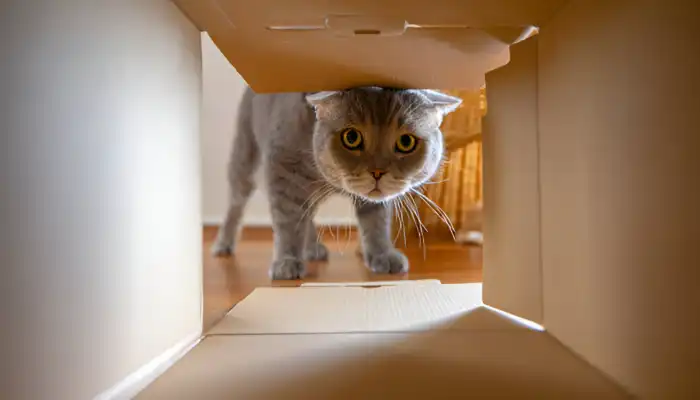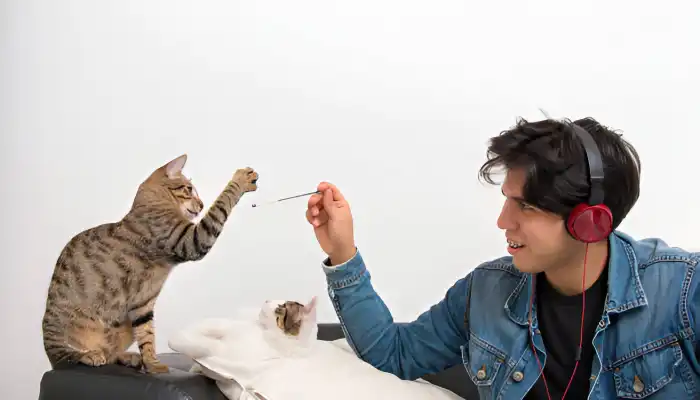English to cat translator tools are designed to help us understand our feline friends by interpreting their vocalizations, such as meows, purrs, and hisses. While these devices and apps aim to bridge the communication gap between humans and cats, they are still in the early stages of development.
In this article, we explore the types of English-to-cat meow translators, how they work, their limitations, and their potential future. Despite the challenges in accurately translating cat behavior, these tools offer a fun and engaging way to better understand your cat’s sounds and emotions.

English to Cat Translator: Does It Understand Cats?
An English to cat language translator online is a tool or cat translator a device that claims to translate human speech into Cat language, be it an app or a tool. Such inventions are built to assist humans in understanding a cat’s meows, purrs, and other vocal sounds.
Although this tech does not exist yet, it is an attempt to solve the communication gap that exists between cats and humans.
Types of English to Cat Translators
- Mobile Apps: Various smartphone applications claim to interpret meows and purrs and translate them into human language.
- Wearable Devices: Some pet companies are creating wearable devices that collect data on a cat’s activity and provide insight into its emotions, needs, etc.
- Online Tools: Websites providing English to Cat language translator online, where users can upload pre-recorded cat sounds and receive a “human interpreted” version of it.
The main purpose of these devices and tools is entertainment, and through the Chuckles app, mockery. Even though this phenomenon does not serve a real need, it is still astonishing and amusing to watch people try to “speak” in cat “languages.”.

Cat Talk: How Cats Communicate
A cat’s communication is not just defined by vocalizations, as these creatures also utilize body language and scent. These methods help portray feelings and intentions. But how accurate is the English to cat translator in interpreting these signals?
Sounds a Cat Makes
Cats make a myriad of sounds, each tailored to specific emotions and needs.
- Meows: Cats mainly meow to interact with humans, and the tone, pitch, and length of meow can indicate various feelings.
- Purrs: A cat’s purr is a sign of enjoyment during relaxing situations, but cats also purr when they are suffering because it can comfort them.
- Hisses and Growls: These sounds often indicate that the animal is feeling discomfort.
Cat Movement
Almost every aspect of a cat’s movement speaks volumes about their emotional state.
- Tail position: To identify friendly cats, look for those with stretches to raise upright. Cats that exhibit fear tuck their tails in close to their bodies.
- Ear position: Ears turned to the front signal attention and inquisitiveness, while ears turned back indicate annoyance.
While an English to cat translator can attempt to interpret meows, it cannot translate body language, which can be equally essential to getting to know how a cat feels.
Scent Marking
Cats use scent marking for two things: to test their territory and to communicate with other cats. An online English to cat translator might help in translating vocalizations but would fail to interpret these subtle scent markings.
A cat’s communication goes beyond just sounds, involving body language and scent to express emotions. While English to cat language translator online attempt to interpret these signals, they can’t fully capture the complexity of feline communication.

Turning English into Cat Sounds
The approach behind such English to cat translators is fundamentally used for sound dissection and pattern identification.
Such devices capture the vocalization of your cat and use machine learning algorithms to identify matching meows, purrs, growls, or even silence, correlating them to emotions or requests made by the owner.
Sound Recognition
One of its first steps, an English to cat translator claims to translate, is recording your cat’s sounds. Some apps or devices use specific audio samples (meows, purrs, hisses) to either analyze or match these samples against known feline or infra-feline vocalization patterns.
Pattern Matching and Translation Algorithms
The English to Cat language translator online uses deductive reasoning on the sound. Once it is recorded and captured, the cat meow translator attempts to match it with other known cat sounds. Such databases are usually created from research on how various cats interact with humans and what sounds they relate to. Based on the analysis, the tool will then display the result.
Feedback and Learning
In the section on English to cat translators, someone highlighted that these tools tend to get better with time as long as more data is provided for the systems to train and ‘learn’ on. A person can achieve more accuracy by feeding more sounds since the system can build better patterns in recognizing each cat’s voice.
Popular Tools
- MeowTalk: This is perhaps the best-known cat translator app where you can record your cat’s meows and get an interpretation.
- Chatterbox: This is a clip-on device for your cat’s collar that attempts to ‘translate’ your cat’s sounds into human speech.
English to cat translators analyze your cat’s sounds using machine learning to match them with emotions or needs. While this approach can provide some insight, it’s still limited in fully understanding your cat’s communication.
Do Cat Translators Understand Cats?
Regarding the effectiveness of English to cat translators, the accuracy tends to be, at best, a mix. The technology has the capacity for future growth and has its unique form of entertainment, but as it stands, there are a lot of caveats.
Usefulness for Cats:
Many cat owners use these apps for fun, as they often translate their cat’s sounds inaccurately and humorously. For example, a purring cat might be translated as “I’m happy!” or a hissing cat as “Stay away!”
Application Translations:
Some apps claim to interpret a cat’s emotions like hunger, fear, or happiness. While they offer some insight, they can’t fully capture a cat’s emotions since much of their communication relies on body language and scent, not just meows.
Researcher Views
Animal behavior researchers believe English to cat’s Voice translators can interpret some cat sounds but aren’t very accurate. They argue that cats communicate more than just meows, growls, or purrs, and understanding them requires looking at their body language and overall behavior.
Disadvantages of English to Cat Translators
It is important to note the limitations that accompany this new technology regarding English-to-cat voice translators. Here are a few limitations of pet translation devices.
Human Language vs. Cat Behavior:
Cats do not communicate like humans through speech. They possess the ability to utter words and use body language to express their feelings.
Context is Key:
Cats lack verbal communication; therefore, several cats could produce the same sound, but those sounds could differ in translation based on context. The English to cat translator will fail to deliver one-size-fits-all translations.
Lack of Understanding of Non-Vocal Communication
Body Language:
Cats communicate through their bodies by moving their tails and ears, in addition to their facial expression. Due to the multi-modal nature of cat communication, many of the details are often left out in many devices that are supposed to capture phrases or sentences.
Other Non-Vocal Cues:
In addition to bones, cats gesture and mark territory with their scents, which an English to cat translator cannot interpret.
Blurring the Nuances of Fundamental Cat Sounds
Translators tend to partially understand the vocalizations issued by domestic cats. The sound “meow” indicates a cat’s need to be fed, loved, frustrated, or inquisitive. In simpler forms, it usually boils down to one generic term, which makes the tool’s output quite unreliable.
While English to Cat translators offer interesting insights, they come with limitations. It’s important to recognize that these tools can’t fully capture the complexity of feline communication.
Do Cats Remain an Unknown Reality?
Knowing cats is more than just interpreting words. Certainly, an English to cat language translator Online will help you communicate, but a lot more needs to be solved regarding what the cat does.
Cats Have Various Ways to “Speak”
Cats communicate through a mix of sounds, body language, and facial expressions, which can’t fully be captured in human speech. While a meow’s tone can be translated, things like the cat’s body position, facial expression, and tail movement are important details that translators miss.
Communication with Pets and the Owners’ Bonding Effects
In many households, it is common to observe that owners of cats and other pets tend to distinguish some peculiar sounds made by their pets because of frequent interactions. An English to cat translator would have a hard time understanding this “language” because of the close relationship between a cat and her owner’s pet.
Constraints to the Variation of Emotion
Cats may feel an emotion-based spectrum, but the ability to express that emotion or relay its complexities is not as broad as a human’s. A translator is more likely to come up with words like “hungry” or “happy,” but won’t be able to interpret more intricate emotions.
Understanding cats goes beyond translating their sounds; it’s about observing their behavior and emotions. English to cat translators can help, but they can’t fully explain the complexities of feline communication.
Helpful Features of Cat Translators
English to cat translators boasts several useful functions that can serve pet owners, notwithstanding the restrictions that the tool may bear.
Instilling Command Over Restraining Behavior
Score owners scratches, biting, or any such behavior that caregivers deem unwanted or abnormal. English to Cat translators may help owners exercise the cat’s restraint posers by identifying the signals of stress or fear.
Example: If the cat starts scratching or clawing at the door, a translator might recognize this as some expression of being fed up or wanting to desecrate the door. This can assist owners in figuring out when their cats are borderline annoyed or in a state of discontent.
Building a Stronger Bond with Your Cat
- Not only capture the cat’s attention but let her gaze out of the window and understand with translation what her body language might indicate. Make her understand effective ways of showing unhappiness and fondness.
- Clarification: A cat that purrs and meows simultaneously may express emotion while requesting food. Understanding this can help owners respond appropriately to their pets.
Interaction with A Vet and Health Tracking
- Perhaps some translation applications could help veterinarians assess a cat’s emotional state or distress during a health check. This could enable proper interventions to be made as early as possible or to utilize better communication techniques to control pain.
While English to cat translators offer some helpful features for pet owners, they still have limitations. These tools can enhance your understanding of your cat, but they’re not a complete communication solution.
Cat Translator FAQ
This is where we answer the most common questions concerning English to cat translators. If you want to know the inner workings and real capabilities of these tools, then read on!
1. Can Cats Understand Human Language?
Cats can understand certain human sounds and tones, especially related to food or play, but they don’t understand human language the way we do.
2. What is an English to Cat Translator?
An English-to-Cat Voice Translator is a tool that tries to turn human speech into something a cat might understand, like interpreting meows and body language.
3. Does the English to Cat Voice Translator Work?
These tools can give you ideas about what your cat’s sounds mean, but they’re not always accurate. They’re more for fun than real communication.
4. Are There Any Reliable English to Cat Language Translators Online?
There are some English to Cat language translator Online Tools, but they vary in accuracy. Most are still being developed and are not perfect.
5. How Accurate is the English to Cat Translator?
Accuracy is limited. These tools can give you some insights, but they won’t always translate your cat’s sounds correctly.
We hope this FAQ has helped you understand the basics of English to cat translators. While they’re fun and insightful, remember that true communication with your cat takes time and patience!
Conclusion
English to cat translator tools are a fun and innovative way to explore the idea of communicating with your cat. While these devices can provide interesting interpretations of meows and purrs, they are far from perfect.
The technology is still developing, and true communication with cats goes beyond just sounds, including body language and scent. Though these translators offer entertainment and some insights, building a deeper bond with your cat requires patience, observation, and understanding of their complex ways of expressing emotions.
